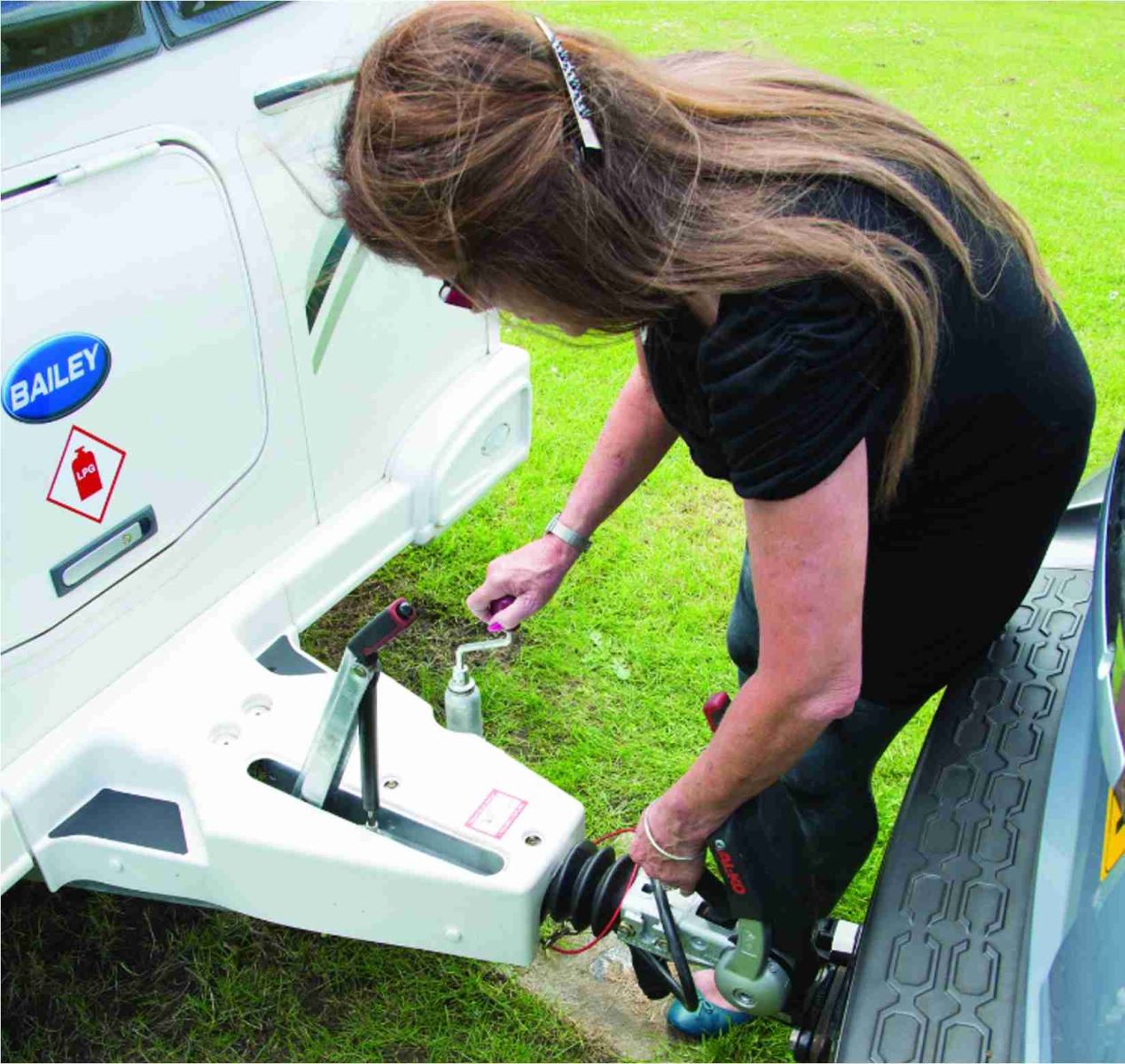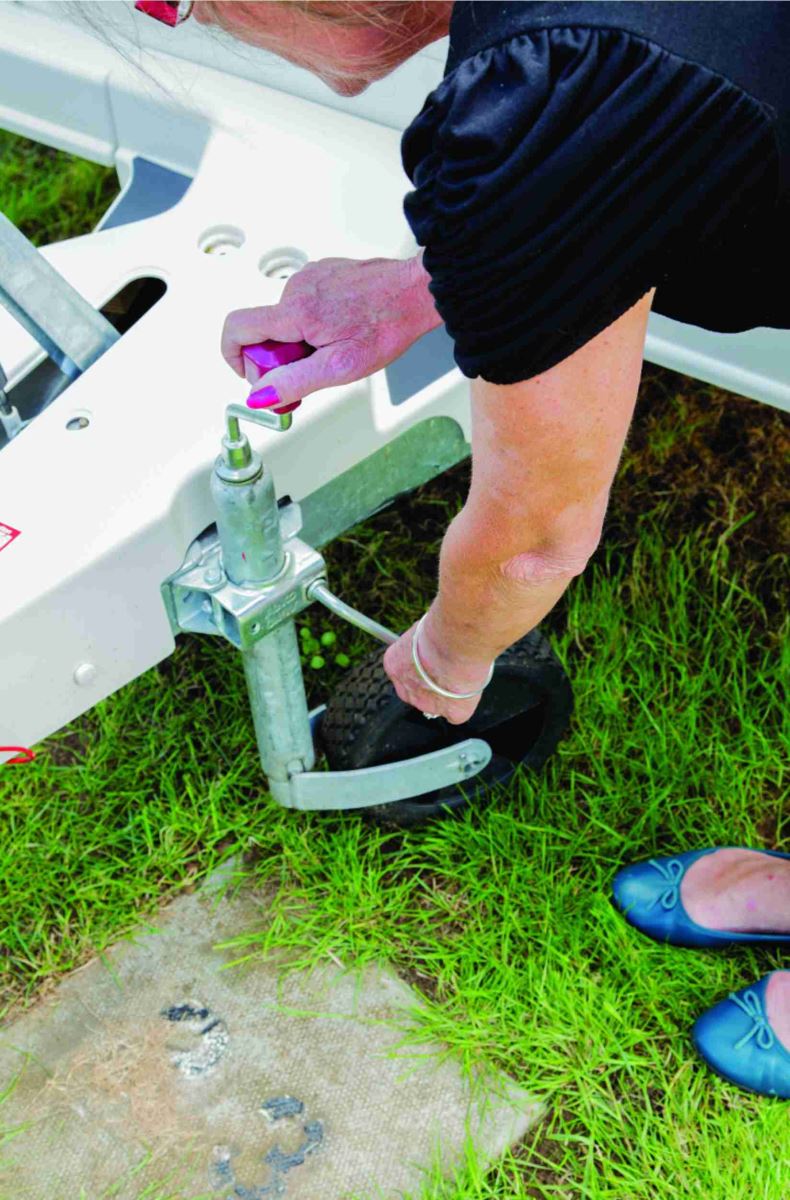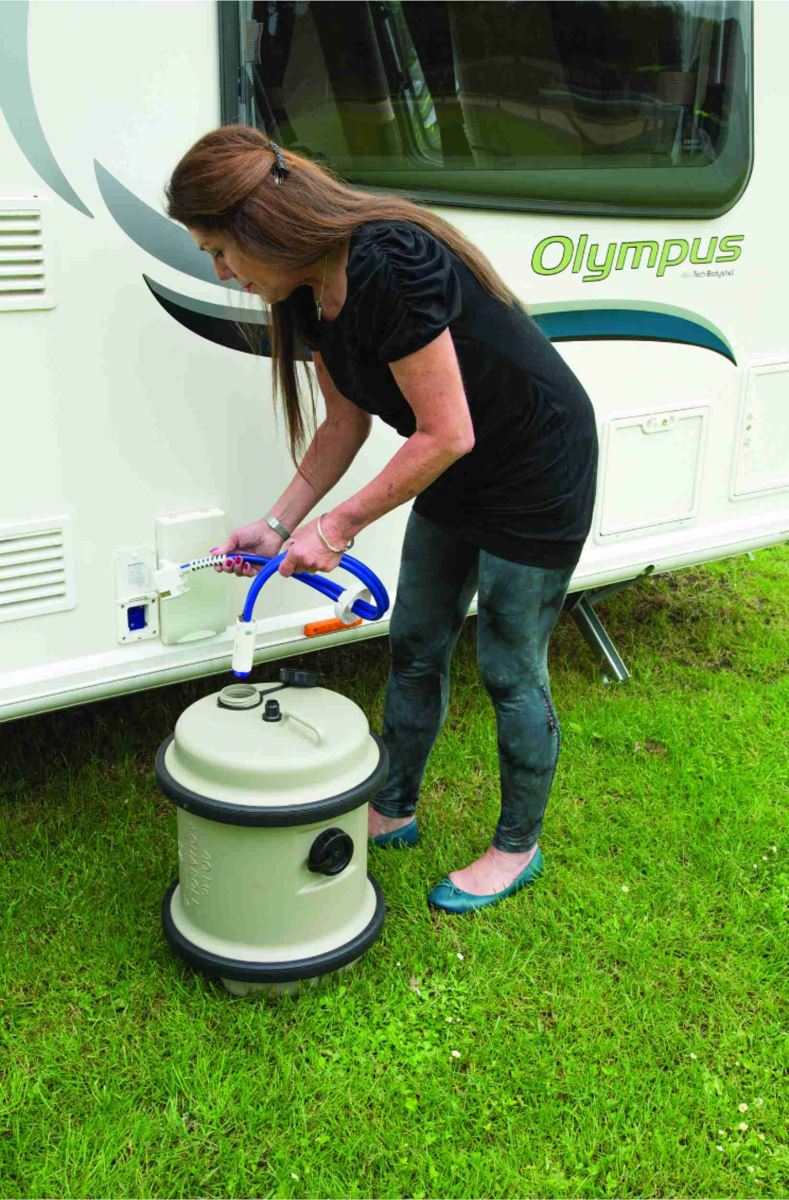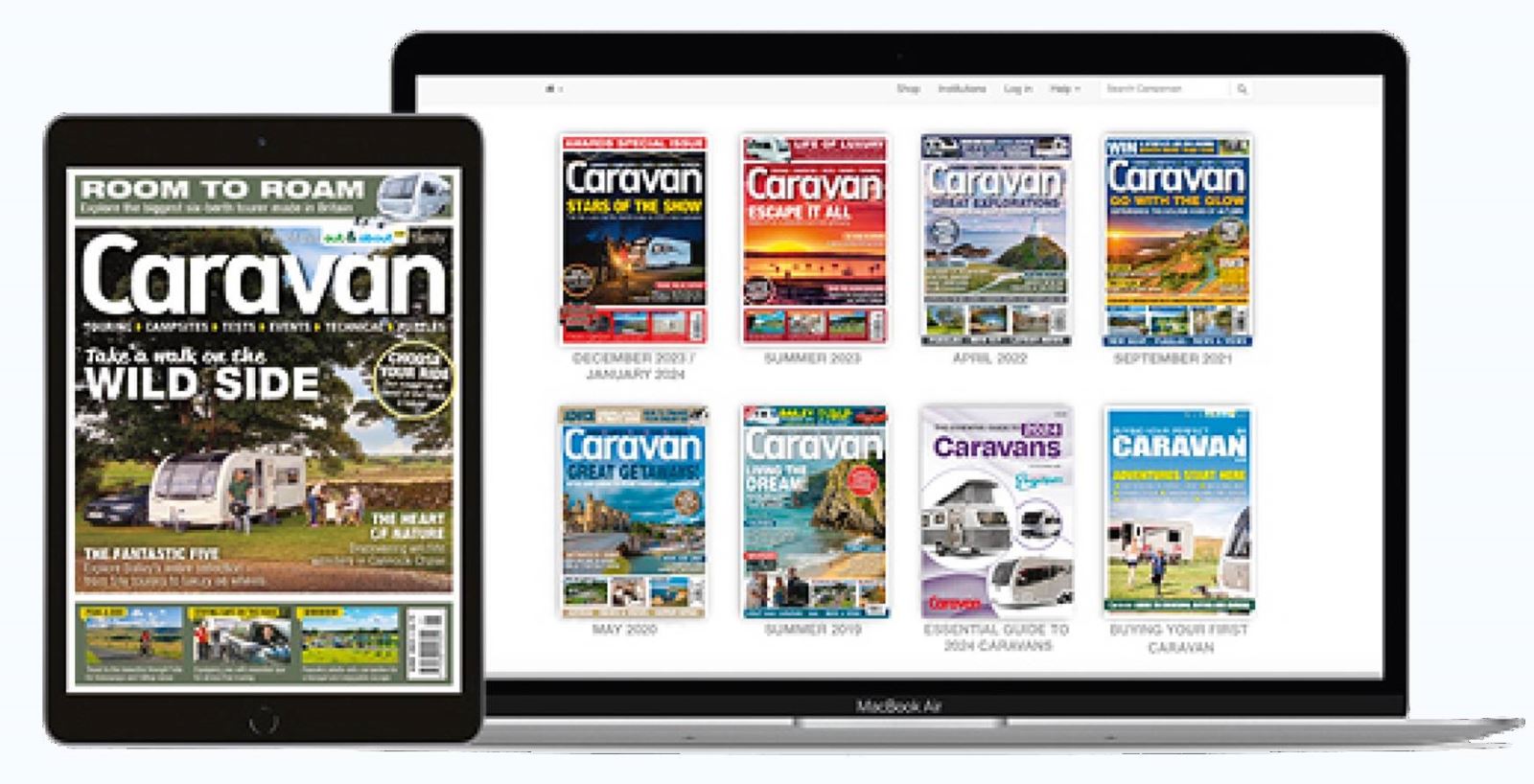How to set up a caravan: all you need to know
Positioning your caravan accurately, unhitching it from the car, getting it level, lowering the corner steadies, connecting the electricity cable and the water…
Setting up your caravan on a campsite pitch is just a sequence of actions. They’re second nature to experienced caravanners.
But if you are new to caravanning, setting up your caravan may seem daunting. Follow our detailed guide and you will quickly get more confident.
Page contents
- Arriving at a campsite
- What to know about setting up a caravan
- Why it is important to know how to pitch up properly
- At-a-glance caravan set-up checklist
- Preparing to leave your caravan pitch
- Final thoughts
- About our magazines
Words by Val Chapman
Arriving at a campsite

(Photo courtesy of Val Chapman)
Your first task is to accurately position the caravan. This is usually done by reversing onto a pitch. Some pitch boundaries are clearly marked by hedging. Others have a marker post and you need to make sure your caravan is positioned to align with it. Some have a pitch number on a concrete slab set into the turf, and you have to position your jockey wheel on this marker slab.
The great majority of caravan owners choose to have a motor mover fitted – that makes the task of positioning your caravan super easy. You unhitch, then activate the mover, and this enables you to move your caravan in a much more confined space than when attached to the car, simply because of the overall length of a car and a caravan.
What to know about setting up a caravan

(Photo courtesy of Val Chapman)
Firstly, before you unhitch, check that the damper on the hitch is not compressed; it becomes compressed if the last action was in reverse, so the car has pushed the damper inwards.
Pull the car forwards slightly, until the ram extends and the bellows on the damper are expanded into their natural position. If you don’t do this, when you unhitch, the damper will expand, easing forwards, possibly making contact with the bumper of your car.
Next, apply the caravan’s handbrake.
If the caravan is on a slope, place chocks behind or in front of the wheels as appropriate.
Before you release the clamp on the jockey wheel, give the handle about six turns to slightly lower the wheel on its shaft. By doing this, you get more length of shaft when hitching up again.
If you don’t do this, you may find that, when you hitch up, you can’t lower the jockey wheel enough for it to engage on the ball. (If this happens, lower the front corner steadies to support the caravan, then raise the jockey wheel by releasing the clamp handle and moving it up in its shaft. Secure it with the clamp, then lower the wheel by turning the handle on the top, until you have enough length of shaft to lower it down and onto the towball.)
Release the clamp on the jockey wheel by turning the lever handle anticlockwise until you can lower the jockey wheel and it touches the ground. Tighten it in its clamp by turning the lever handle clockwise.
When the jockey wheel is on the ground, detach the 12V cable from the car. Now, unhitch the caravan from the car by lifting the handle on the hitch head and winding the handle on top of the jockey wheel. The hitch will start to rise until the hitch cup detaches from the towball.
Finally, unhook the breakaway cable from the towbar (this is the coated wire that, in the event of the caravan parting company from the car in an incident while it is being towed, will pull the brakes of the caravan on).
Drive the car clear out of the way, and then wind the jockey wheel up or down, until the caravan is sitting approximately level.
Now it’s time to get your caravan level. A spirit level is useful; most phones have spirit levels, but a simple plastic one can be bought from caravan retailers’ accessory shops.
First, level it laterally. You can use a plastic levelling ramp (again, available from accessory shops), placed under the wheel that is on the side that needs to be raised. Now tow the caravan up it until it’s level. Apply the handbrake.
That’s fine for a single-axle caravan but twin-axle caravans need more than one ramp. Some caravan owners use a plank of wood; we’ve done this and it can work fine. A better solution is a device called LocknLevel. This is basically a tough air bag and a tyre inflator. For twin-axle caravans, you buy the twin unit, with two bags. You place the bag/s forward of the wheels (or behind if you intend to reverse onto them). Tow the caravan so that the wheel or wheels are on the bags. Now inflate the bag/s using a tyre inflator, until your spirit level tells you that the caravan is laterally level.
Now it’s time to get the caravan level front to back, by winding the jockey wheel until your spirit level tells you that the caravan is level. Now lower the corner steadies, by placing the socket of your caravan’s corner steady winder over the nut on the winding mechanism. Wind it until the corner steady’s foot is flat on the ground. Most caravan owners use a drill with a corner steady drill attachment; this mechanises the process rather than having to manually wind!
It is vital not to overtighten corner steadies as damage can result, and never be tempted to use the corner steadies to level your caravan. Corner steadies are exactly what their name implies – they are not intended to support the weight of the caravan but just to steady it.
Connect your mains electricity cable to the caravan’s socket, then the other end to the power point on your pitch. If you store your cable on a drum, completely unwind it from the drum. This allows any heat generated to dissipate. (If you leave it coiled up, there is a small chance of heat build-up causing a fire.)
Now it’s time to turn on the gas supply, by turning the knob on the regulator of the gas cylinder to the ’on’ position.

(Photo courtesy of Val Chapman)
A hose and pump assembly will be provided with the caravan to get the water from your water container to the caravan’s water system. Connect it to the caravan's water inlet and then place the other end in the water container.
Some types of connector have a submersible pump on the water container end. Others, those for caravans that are equipped with an inboard pump – a pump situated under seating – have a water filter on the end of the hose.
To connect the waste water outlets to your waste water container, you’ll need a length of grey hose (this can be bought by the metre from accessory shops) and a Y-shaped connector to join the shower and sink outlets into one hose. This means that, for convenience, one single hose goes into your waste water container.
Now it’s time to put the kettle on!
Why it is important to know how to pitch up properly
The importance of getting your caravan level may seem obvious. If it is not level, things cooked in the oven will slide to one side of their container. Less obvious is that, for optimum efficiency, fridges need to be level. And, if your caravan isn’t level you will certainly become aware of it when you get into bed; beds are less than comfortable when they are on even a slight slope!
At-a-glance caravan set-up checklist
- Position the caravan accurately on the pitch
- Lower the jockey wheel
- Chock the caravan wheels if you are on a slope
- Apply the handbrake
- Unhitch by raising the lever at the front of the hitch head and wind the jockey wheel until the towball is clear of the hitch cup
- Disconnect the 12V connector from the car
- Disconnect the breakaway cable
- Drive the car away
- Lower the corner steadies
- Level the caravan
Preparing to leave your caravan pitch

(Photo courtesy of the Camping and Caravanning Club)
Check that all of your caravan's windows and rooflights are closed and secured.
Make sure everything is stored securely inside and cupboard doors are firmly closed and latched.
Retract your TV aerial.
Disconnect the waste and fresh water pipes and store the empty containers in the car or caravan. You can buy bags for these but we have found that heavy-duty bin bags are a cheap-yet-adequate substitute.
Disconnect the mains electricity cable from the hook-up post and then the caravan, and store the cable in either the car or caravan – an exterior-access hatch on the caravan is ideal for this.
Turn the fridge to 12V; in this mode it draws power from the car’s 12V system when the engine is running. When you stop the engine, the 12V supply is automatically cut off, so that your car’s battery power can’t be depleted by the fridge, causing a flat car battery. Some caravan fridges automatically select to take power from the car battery when you hitch up.
Don’t forget to remove the microwave’s glass plate before you start towing – unless you caravan’s microwave is a ‘flatbed’ which means there is no separate glass plate.
Raise the corner steadies; have a specific routine for this to make sure you raise them all. We find it’s a good route to start at the front nearside, then the back two and finally end with the front offside.
Make sure you remember to put your towing mirrors on – this is a legal requirement. And check that they are adjusted properly so that you have maximum field of vision.
Hitching up can be done in one of four ways. If there are two or more people, and the caravan is light enough, you can pull the caravan towards the towball. However, don’t try this if the caravan is on a slope. It can also be difficult on deep gravel or mud, so you’ll need to assess this before trying to move the caravan.
A much easier method is to reverse the car so that the towball is positioned under the caravan hitch. If there are two of you, one person can stand by the caravan and give instructions to the driver to enable him/her to position the ball right under the hitch. Lone drivers can also hitch using this method – it just takes longer without guidance.
The third method is to use the car’s reversing camera, if you have one.
The fourth method, of course, involves a motor mover. You can draw your caravan towards the car and position its hitch accurately above the towball easily.
When you’ve attached the ball into the cup, push the handle of the stabiliser down into position. When you do this, the friction pads within the cup engage on the ball. This should require a little strength to push it down; if not, it indicates that the friction pads may need adjusting or replacing. That’s a job for a caravan dealer as hitch-head stabilisers are safety features.
Connect the breakaway cable to the dedicated loop on the towbar, or loop it around the neck of the towball. When using a dedicated loop, it is important to pass the cable through the loop and then clip the cable onto itself. Do not clip the cable to the loop – the clip may be too weak to activate the brakes.
Wind the jockey wheel up as far as it will go. Then undo the clasp and lift the jockey wheel up until it won’t go any further. Secure the clasp tightly.
Connect the caravan’s car electrical connections to the socket on the back of the car. Check that the road lights on the caravan work. Do this every time you tow.
It’s best done in the same sequence every time, so that you don’t forget anything and also for ease of communication between the driver and the person at the back of the caravan who is checking the lights. We find a useful and easy sequence to remember is: side lights, brakes, then right and left indicators.
Final thoughts
Setting up a caravan on arrival at a pitch is easy – it’s just a sequence of actions that, once you become accustomed to the routine, become instinctive. A checklist is useful to make sure you don’t forget to do something, especially if you are new to caravanning.
Even though you may consider some of the set-up tasks as chores, they quickly become part of the entire enjoyment of caravanning.
And when it’s time to pack up and leave, those tasks quickly become instinctive, too. You will soon find that, especially if you are caravanning as a family, each family member can have their tasks and you can work as a team.
Expert Caravan advice to your door!

Caravan magazine has been inspiring caravanners for more than 80 years! We have grown to become a leading authority on caravans, the caravan industry, caravan lifestyle, campsites and caravan travel destinations. We know what our readers want – and that's to make the most of their caravans and their holidays!
Want to know more about Caravan magazine?
About Caravan magazine








Recent Updates
Caravan chassis: all you need to know
A caravan chassis is a skeletal frame that runs from front to back, supporting the body and linking the entire structure to the axle or axles ...
Caravan cooking recipes
Caravan cookery inspirational ideas. No need to stress out in the kitchen with these quick and easy ...
Caravan satellite dish guide: everything you need to know
Few holiday types can rival the escapism of the humble caravan, but we all love to sit back and relax in ...
Caravan insurance: all you need to know
Navigating the world of caravan insurance can feel like a daunting task. Fear not, as this comprehensive ...
Caravan tyres: everything you need to know
In this tyre guide, we'll explain everything you need to know about looking after your caravan tyres and ...
Caravan solar panels: all you need to know
Whether you dream of roaming off-grid or just fancy reducing your carbon footprint, fitting solar panels to ...
Caravanning with dogs: all you need to know
Caravan holidays with dogs are a joy for lots of reasons. Firstly, many people choose to buy a caravan ...
Caravan showers: all you need to know
In this guide, we’ll discuss the different types of showers, how they work, and how to fit an external shower ...
Towing a caravan: all you need to know
Towing a caravan may seem daunting initially, but a few simple tips can make the journey enjoyable and ...
Towbars & towballs: all you need to know
Flange, detachable, swan neck, retractable – towbar technology choice is bewildering. Don’t worry. We’ll ...
Other Articles
Caravan WiFi: everything you need to know
Caravan holidays are the ultimate way of getting away from it all, although we sometimes need a link to the outside world ...
Buying a caravan: what you need to know
Let us guide you through some of the complicated things to think about when first looking at buying a ...
Caravan awnings: a buyers' guide
Caravan awnings are a fantastic addition to any caravan as they are one of the simplest, quickest and most ...
Caravan electrics: avoid tripping out
All caravan owners have overloaded their mains supply at some time. Here’s how to master caravan electrics ...
Caravan heating systems: a quick guide to caravanning warmth
When winter is here, you’ll be glad of a decent caravan heating system if you’re out touring. Here’s how the ...
Caravan damp: a complete guide
There's little more guaranteed to strike fear into the heart of a caravan owner than the word 'damp'. But if ...
Caravan jockey wheels: the definitive guide
A well-functioning caravan jockey wheel can make all the difference to manoeuvring away from the towcar, ...
Caravan bike racks: a complete guide
Exploring the beautiful surroundings while on a caravan trip is undeniably one of the greatest joys of the ...
The ultimate guide to caravan layouts
Choosing the right layout or floorplan of your caravan is an all-important part of the buying process – find ...
A guide to seasonal caravan pitches
Our in-depth guide to finding and securing seasonal caravan pitches on your favourite campsite ...